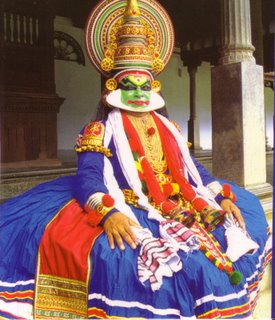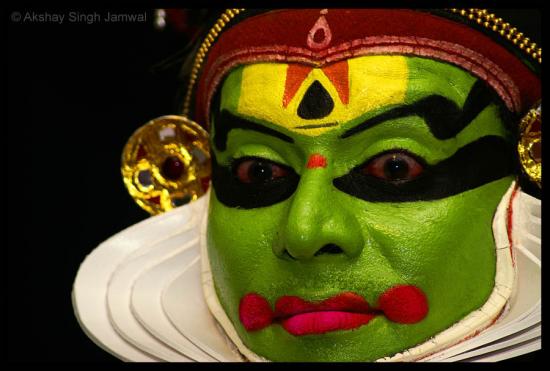Kathakali literally meaning ‘story-dance’ is the dance-drama of Malabar which is now culturally and politically known as Kerala’s soul.It is one of the oldest theatre forms in the world. It originated in the area of southwestern India now known as the state of Kerala. Kathakali is a group presentation, in which dancers take various roles in performances traditionally based on themes from Hindu mythology, especially the two epics, the Ramayana and the Mahabharata.

One of the most interesting aspects of Kathakali is its elaborate make-up code. Characters are categorized according to their nature. This determines the colours used in the make-up. The faces of noble male characters, such as virtuous kings, the divine hero Rama, etc., are predominantly green. Characters of high birth who have an evil streak, such as the demon king Ravana, are allotted a similar green make-up, slashed with red marks on the cheeks. Extremely angry or excessively evil characters wear predominantly red make-up and a flowing red beard. Forest dwellers such as hunters are represented with a predominantly black make-up base. Women and ascetics have lustrous, yellowish faces.

It was believed that Kathakali was conceived from Krishnanaattam, the dance drama on the life and activities of Lord Krishna created by the Zamorin of Calicut. The reason for that is said as follows: Once Kottarakkara Thampuran the Raja of Kottarakkara who was attracted by the tone of the Krishnanaattam requested the Zamorin for the loan of a troupe of performers on the eve of some festive occasion. Due to internal feuds and political rivalry between them, the Zamorin refused to send the performers and insulted with the remarks: ”It is useless to depute the troupe, because Kottarakkara Thespian’s court would be neither able to appreciate nor understand anything of the highly artistic Krishnanaattam and the high standard of the performance”.
The technique of Kathakali includes a highly developed language of gesture, through which the artist can convey whole sentences and stories. The body movements and footwork are very rigourous. To attain the high degree of flexibility and muscle control required for this art, a Kathakali dancer undergoes a strenuous course of training, and special periods of body massage.
The dancers wear large head dresses, and the contours of the face are extended with moulded lime. The extraordinary costumes and make-up serve to raise the participants above the level of mere mortals, so that they may transport the audience to a world of wonders.
The orchestra of a Kathakali performance includes two drums known as the chenda and the maddalam, along with cymbals and another percussion instrument, the ela taalam. Normally, two singers provide the vocal accompaniment. The style of singing particular to Kathakali is called Sopaanam. The orchestra of a Kathakali troupe is unique and provides not only the background to the dancing, but also serves as a highly expressive special effects team. In the traditional village ambiance, the percussionists also provide publicity for the event by playing outside the venue for some hours before the start of the show.
The costume of Kathakali has been much influenced by Chaakkyaar koothu and Koodiyattam the two older forms of dramatic representations in vogue in Kerala. The history of their origins dates back to the period of Perumals i.e. much earlier to the introduction of Raamanaattam. The whole scheme of Abhinaya (acting) and the use of Mudras (hand poses) and gestures were bodily adopted in Kathakali from them in addition to its borrowing and refinement of facial make-up and costume. The use of colour, costume, and make-up present a unique show and create an unearthly atmosphere. Kathakali became more attractive and popular than the Chaakkyaar koothu and Koodiyattam. Moreover ,its performance was not restricted to the precincts of the temples.
Symbols of the hand have played an important role in the art of Kathakali. With the help of Mudras, the hand poses are called in Sanskrit, a whole literary expression is reduced to elementary notions. There are sixty-four basic hand poses which connote five hundred words, while the alphabet of the eyes express emotions. Their permutations can be employed to convey any number of meanings requiring any detailed explanation in the modern concept of story-telling.
A traditional Kathakali performance begins in the evening and continues throughout the night, culminating at the auspicious hour of dawn, when Good finally conquers Evil. Today, however, it has been modified for the proscenium stage, and urban audiences can participate in this ritualistic theatre experience in the comfort of a plush auditorium, within the span of a couple of hours.



